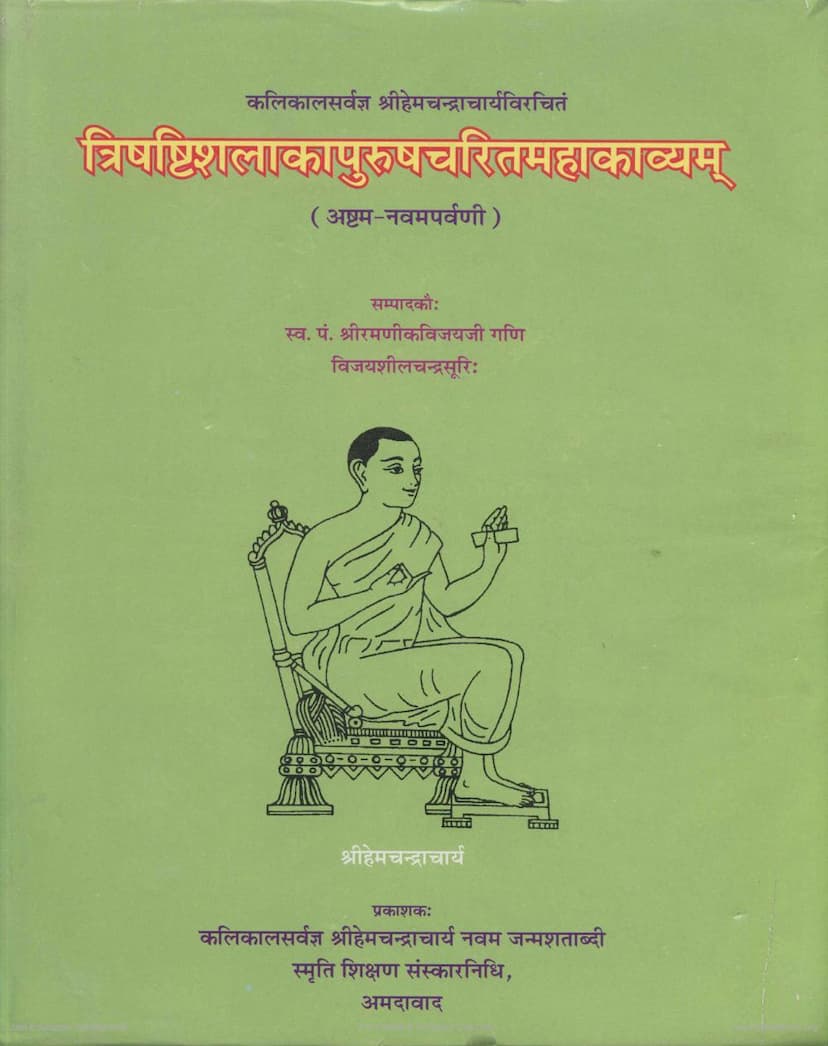Trishashtishalakapurushcharitammahakavyam Parva 8 9
Added to library: September 2, 2025

Summary
Here's a comprehensive summary of the provided Jain text, focusing on the content of "Trishashtishalakapurushcharitammahakavyam Parva 8 & 9" based on the provided pages:
Book Title: Trishashtishalakapurushcharitammahakavyam Parva 8 & 9 Author: Hemchandracharya Editors: Late Pandit Shriman Ramnikvijayji Gani, Vijayshilchandra Suri Publisher: Kalikal Sarvagya Shri Hemchandracharya Navam Janmashatabdi Smruti Sanskar Shikshannidhi, Ahmedabad Publication Year: 2006 AD / 2062 VS
Overall Context: This text is Volume 4 of the Trishashtishalakapurushcharit, a monumental Sanskrit epic poem by Acharya Hemchandracharya. It details the lives and deeds of the 63 great personages (Shalaka Purushas) in Jain tradition. The provided pages cover Parva 8 (Ashtama Parva) and Parva 9 (Navama Parva).
Publisher's Note (Page 6): The publisher expresses immense joy in releasing the fourth part of this epic, coinciding with the 9th birth centenary of Acharya Hemchandracharya. They mention having previously published critical editions of Parts 1 (covering 1st Parva) and Parts 2-3 (covering 2nd-7th Parvas). This volume presents a critical edition of Parva 8 and Parva 9. The trust intends to publish the remaining parts, including the 10th Parva and an appendix. The publication received financial support from the Shri Jain Shvetambar Murtipujak Boarding Institution of Ahmedabad.
Editor's Note (Pages 7-8): The editor, Vijayshilchandra Suri, highlights the 'Trishashtishalakapurushcharit' as a significant Mahakavya by Hemchandracharya, spanning approximately 36,000 verses. He notes its continuous study within the Jain community for centuries, with ongoing reading and teaching among monks and nuns. While several editions and translations (Gujarati, Hindi, English) exist, a critically reviewed and revised reading was lacking. The editor acknowledges the pioneering work of Muni Shri Charunvijayji in preparing the first parva's reading and Muni Shri Punyavijayji for the 2nd-4th parvas.
The current volume is based on the previously unpublished work of the late Pt. Shri Ramnikvijayji Gani for the subsequent parvas. The editor meticulously reviewed these unpublished files, identifying the need to incorporate readings from further significant manuscripts.
Content of Parva 8 (Ashtama Parva) (Pages 9-20): The detailed table of contents indicates that Parva 8 is dedicated to the lives of:
- Adishtanemi (Arishtanemi): Described as the 22nd Tirthankara, born into the Yaduvansh dynasty in Dwarka. His previous lives, his spiritual journey, renunciation, and eventual liberation are narrated.
- Krishna Vasudev: His birth, youth, exploits, and his role as a powerful ruler are covered extensively. The text details his marriages, his relationships, his battles, and his eventual departure from the mortal world.
- Balabhadra (Valabhadra): His life is interwoven with Krishna's, highlighting his strength and actions.
- Jarasandha (Prativuasudev): His antagonistic role, his battles against Krishna and the Yadavas, and his eventual downfall are recounted.
The Parva begins with the auspicious beginnings of rulers, divine pronouncements, and the birth of significant figures, tracing their lives through various stages, including spiritual practices and their ultimate destinies. The content spans numerous episodes, detailing genealogies, battles, religious teachings, and philosophical discussions. The sheer volume of shlokas and topics covered in the table of contents underscores the epic's comprehensive nature, including narratives about the Yadu dynasty, the Vrishni clan, the Pahlavi dynasty, and various other royal lineages and divine beings.
Content of Parva 9 (Navama Parva) (Pages 21-28): Parva 9 focuses on the life and teachings of Parshvanatha, the 23rd Tirthankara.
- Previous Lives of Parshvanatha: The narrative begins by tracing Parshvanatha's previous births, detailing his journey through various existences, the accumulation of merit, and the karmic seeds sown that would lead him to his Tirthankarhood. These stories illustrate the Jain principles of karma and reincarnation.
- Parshvanatha's Birth and Youth: The text describes his birth into the Ikshvaku dynasty in Varanasi, his auspicious signs, his early life, education, and the events leading to his renunciation.
- Parshvanatha's Spiritual Practices: The epic narrates his severe austerities, his enlightenment, and his subsequent teachings.
- Miracles and Divine Interventions: The lives of Parshvanatha are often depicted with supernatural events, including interactions with divine beings, protection from obstacles (like the serpent Dharanendra saving him from Megha Malin), and the establishment of his spiritual order.
- Key Disciples and Royal Patronage: The text highlights the conversion of important figures and the patronage of kings like Ashvasena and his queen Vama.
- The Establishment of the Jain Order: The summary indicates the formation of the four-fold sangha (monks, nuns, laymen, laywomen) and the propagation of the Jain dharma.
Key Themes and Narrative Style:
- Comprehensive Biographies: The parvas offer detailed accounts of the lives of these great figures, covering their birth, youth, spiritual training, worldly actions, renunciation, and ultimate liberation.
- Moral and Spiritual Teachings: The narratives are laden with Jain ethical principles, emphasizing the consequences of actions (karma), the path to liberation (moksha), non-violence (ahimsa), truthfulness, and detachment from worldly pleasures.
- Mythological and Historical Elements: The epic blends mythological narratives with historical context, portraying the interaction of human, divine, and semi-divine beings.
- Poetic Excellence: Acharya Hemchandracharya's mastery of Sanskrit poetry is evident in the rich descriptions, metaphors, and lyrical quality of the verses, even in the structural outline provided.
In essence, Parva 8 and 9 of the Trishashtishalakapurushcharit provide profound insights into the lives of key figures in Jainism, emphasizing their spiritual journeys, ethical conduct, and the unfolding of their destined roles in the cosmic order, all presented through Hemchandracharya's masterful epic poetry.